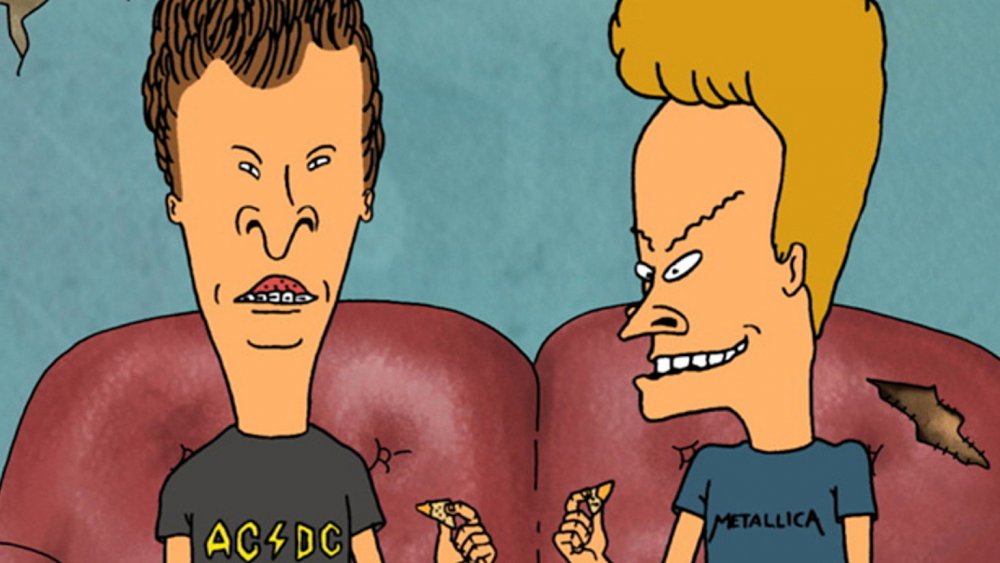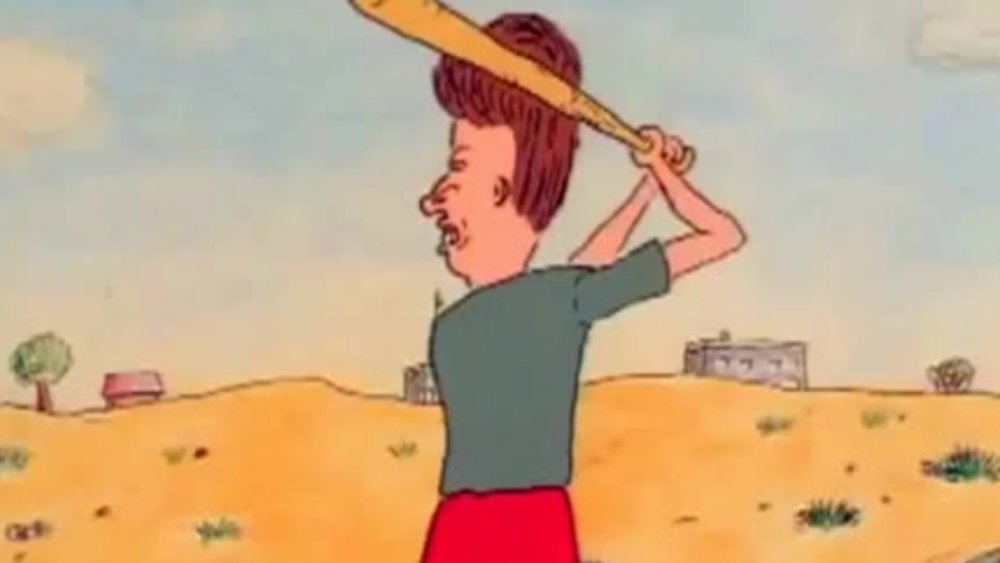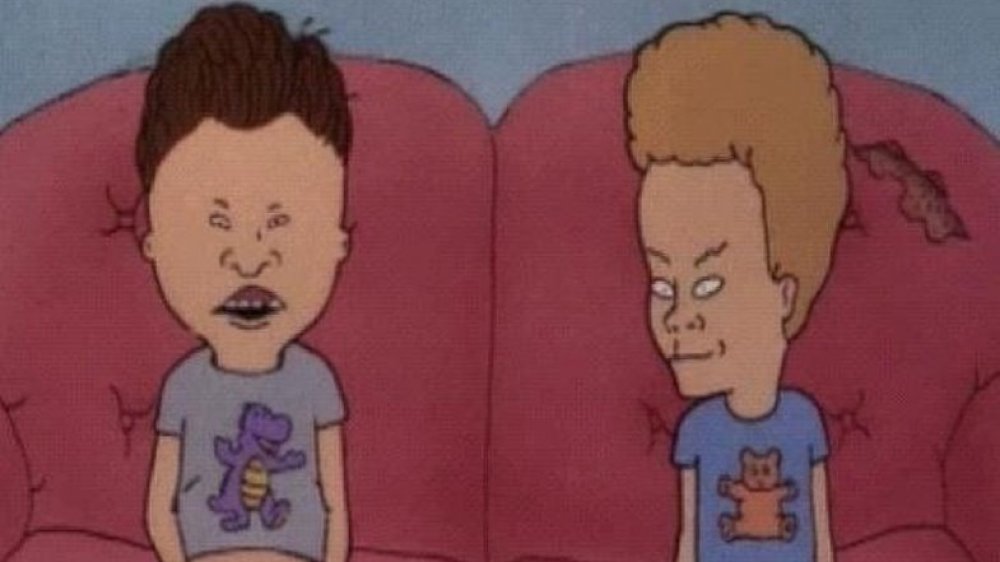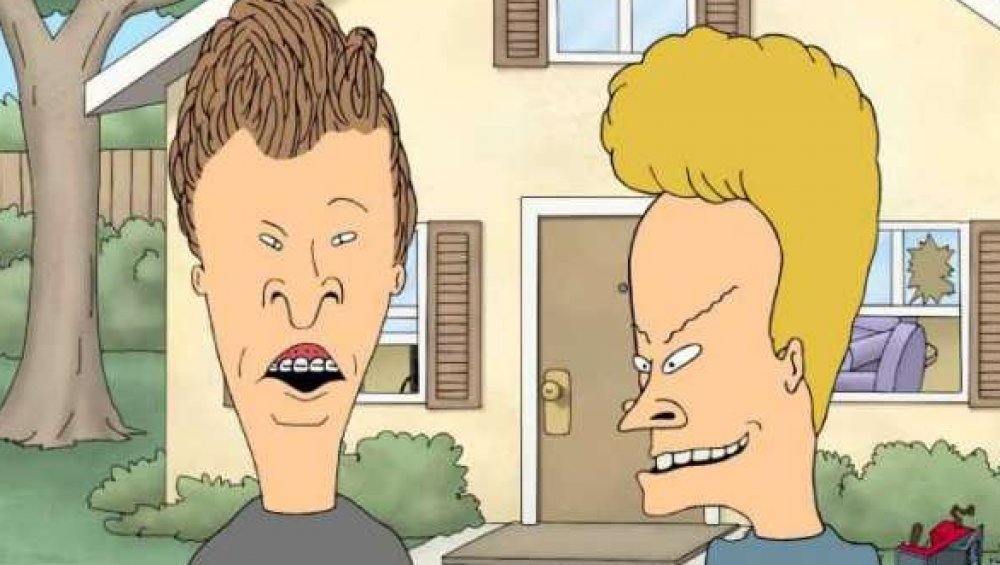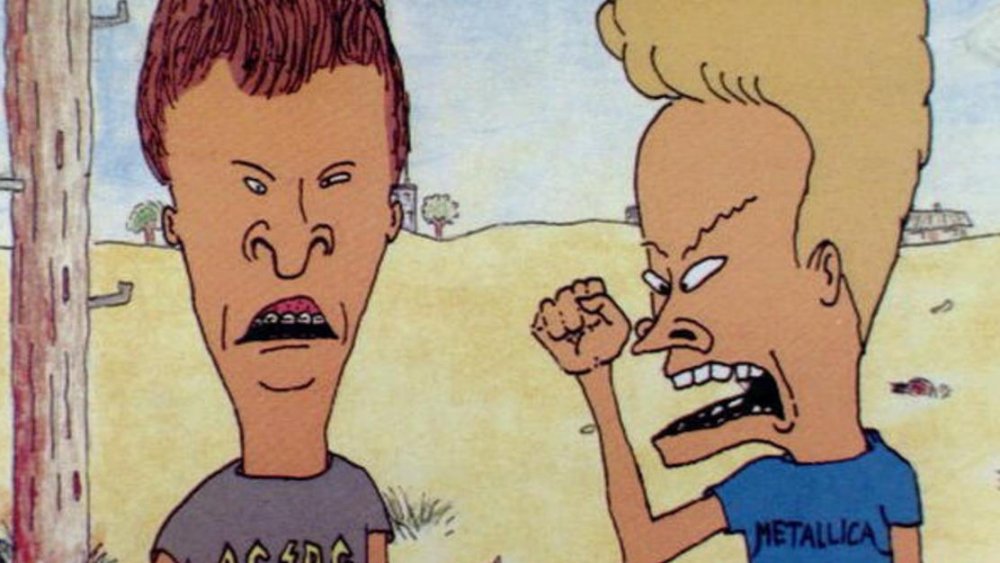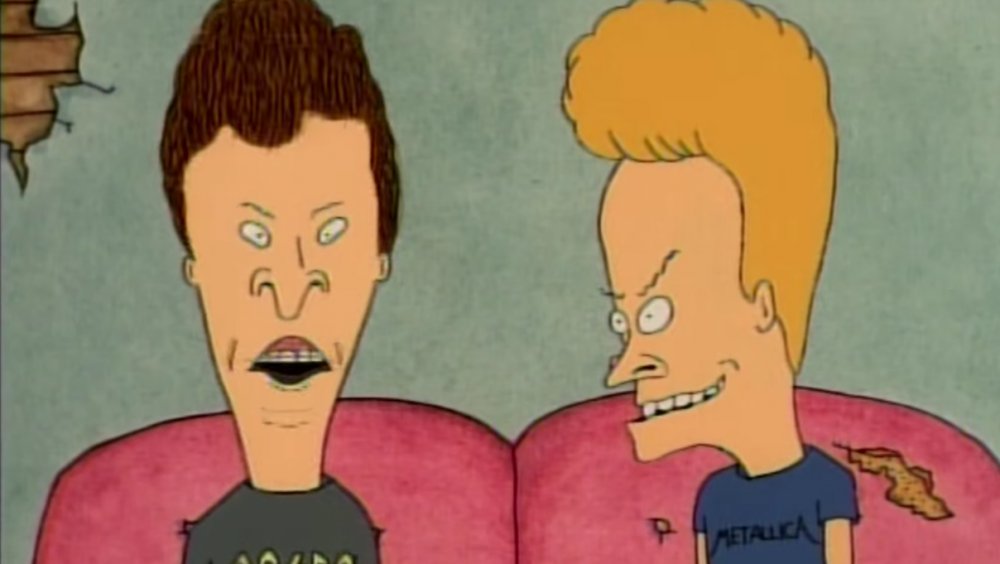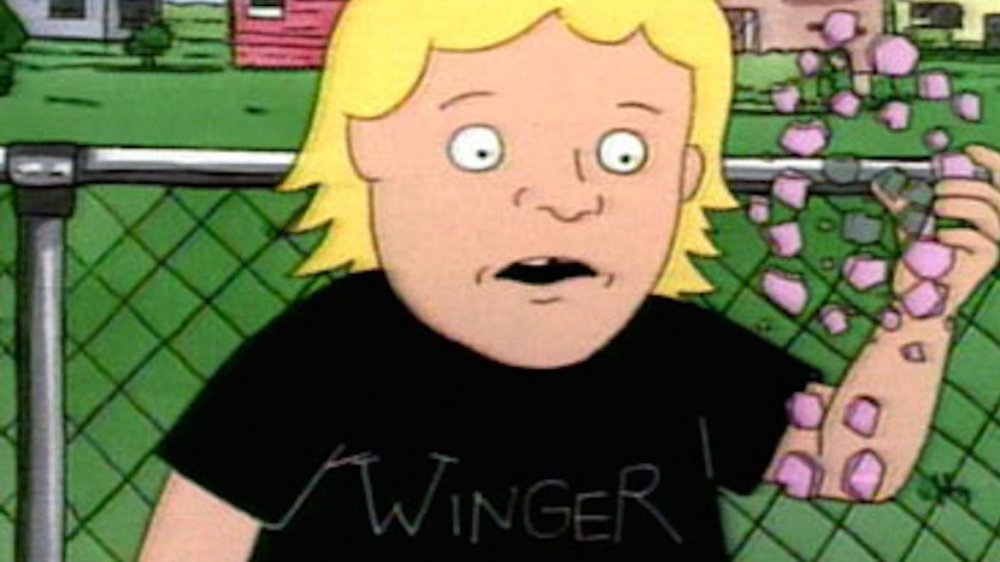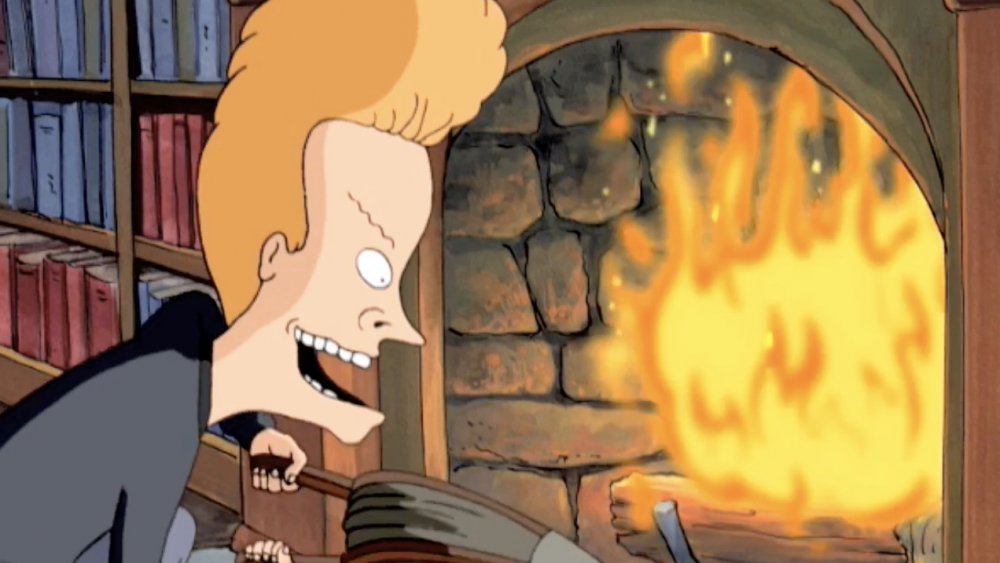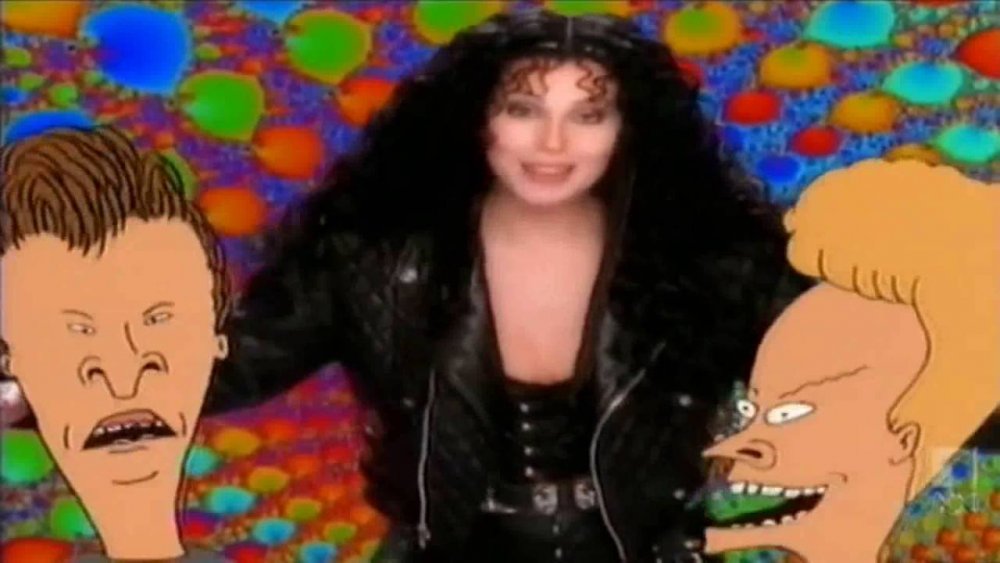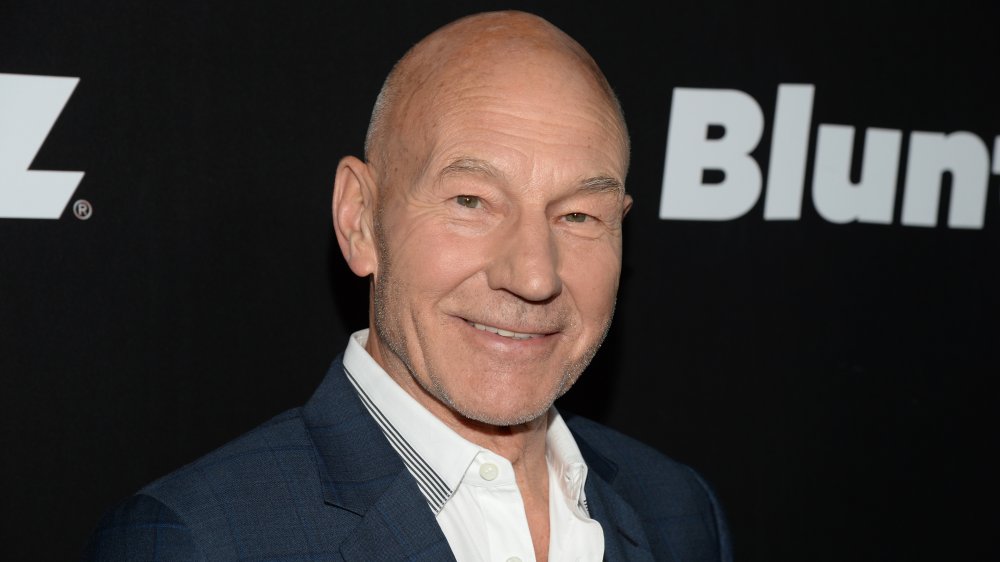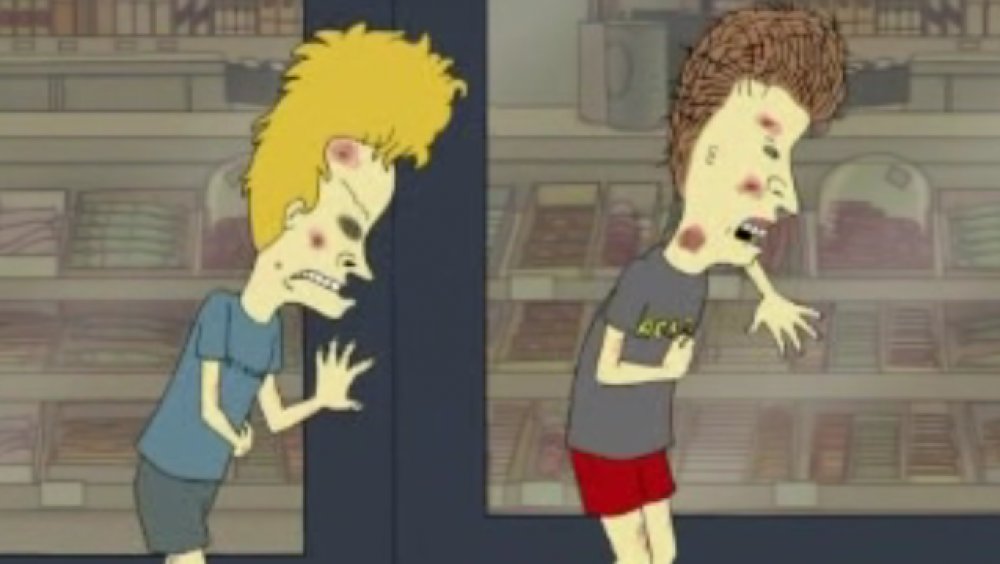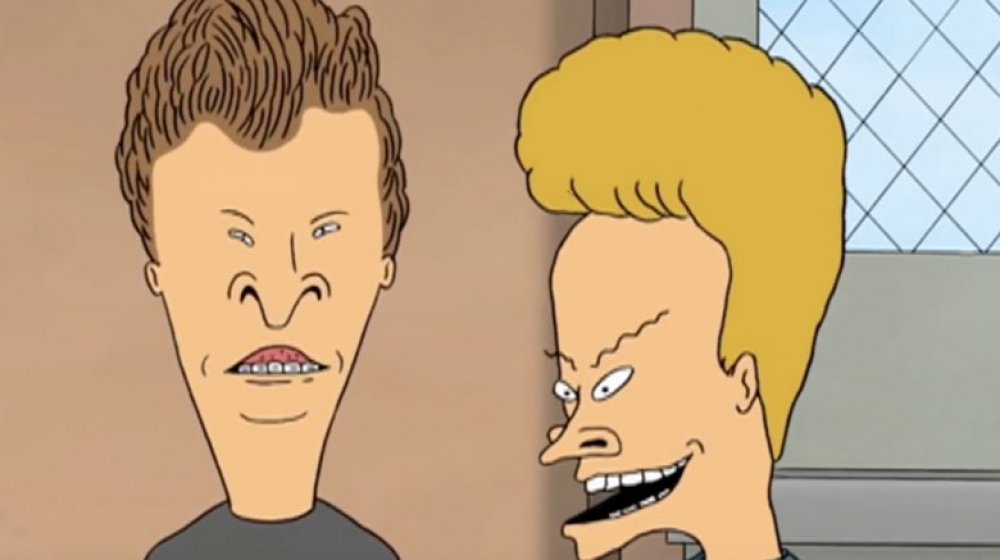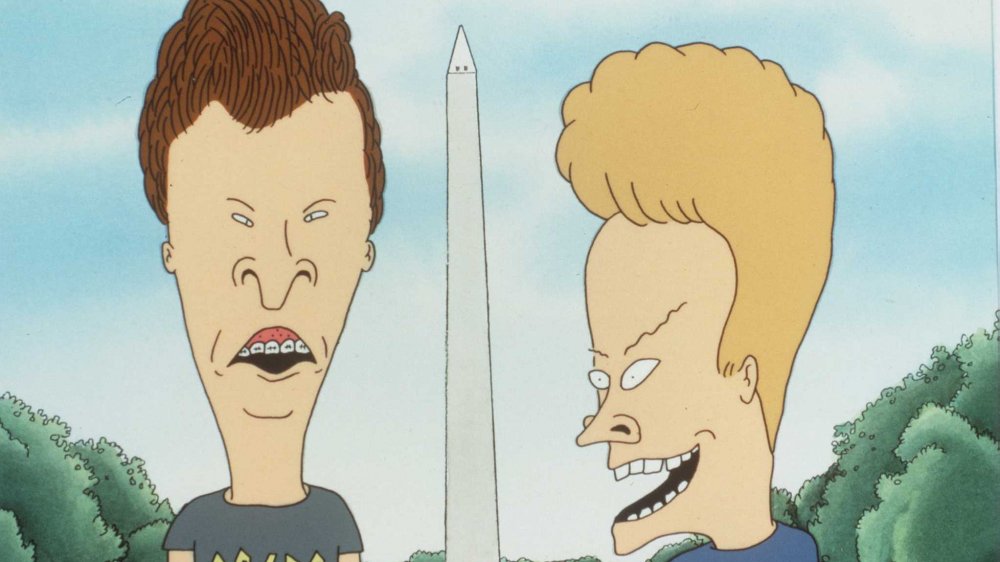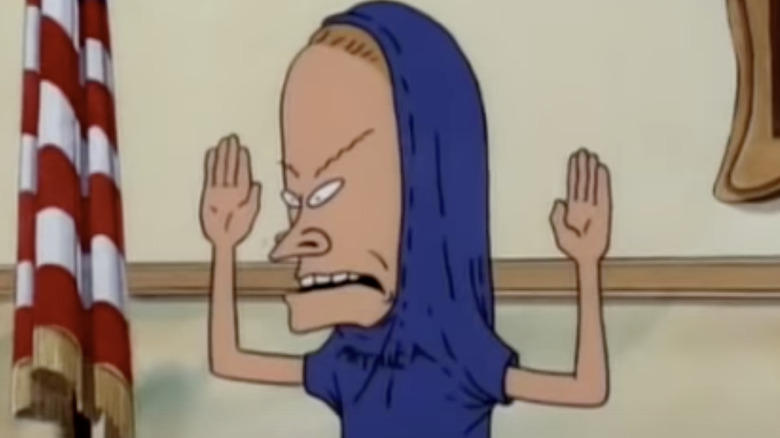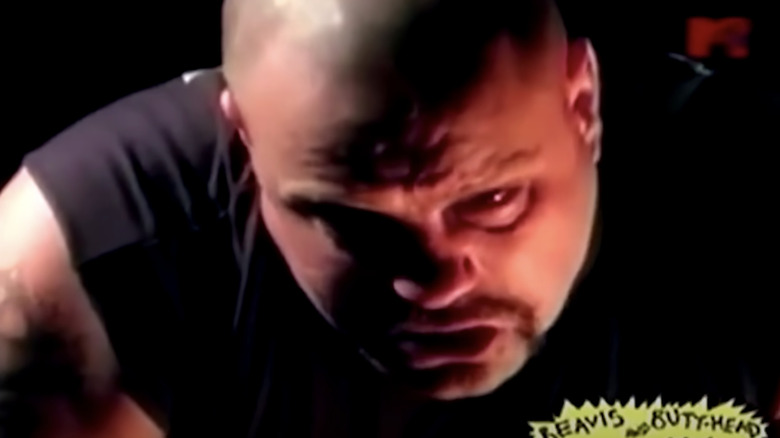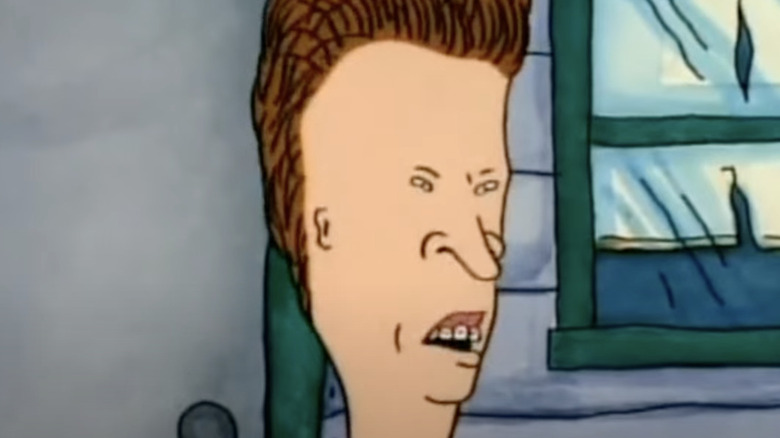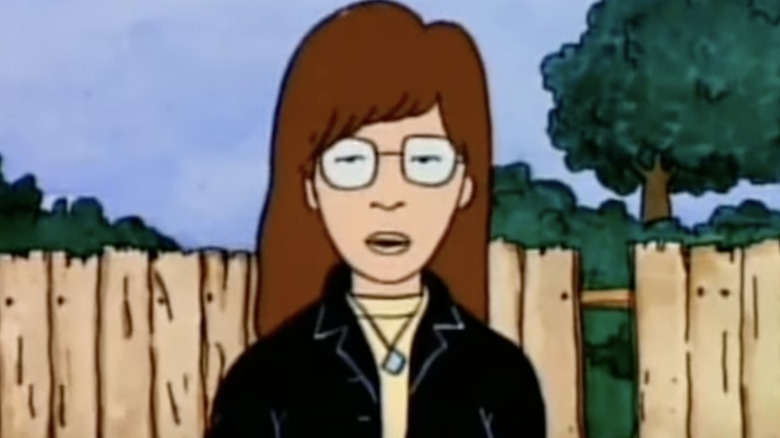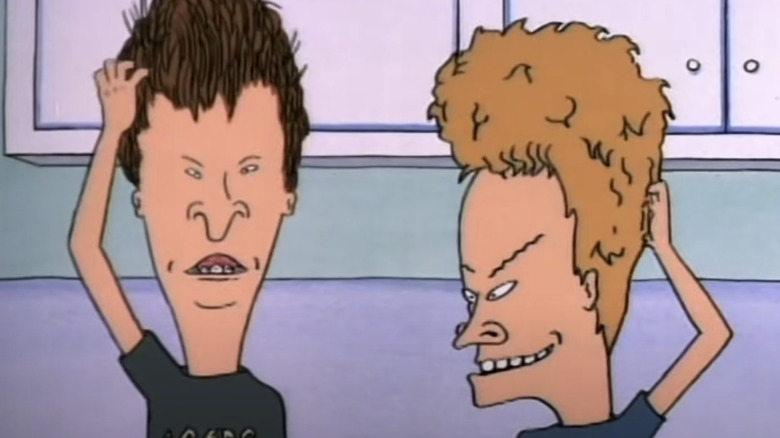The Untold Truth Of Beavis And Butt-Head
In 1993, Mike Judge — the future creator of cultural touchstones like "Idiocracy," "Office Space," and "King of the Hill" — unleashed upon MTV two of the most hilarious idiots to ever grace a screen. That's when "Beavis and Butt-Head" debuted, a show about a couple of impossibly stupid teenagers who liked "chicks," "things that are cool," and hard rock. Conversely, they didn't much care for "things that suck," such as school, work, most adults, and soft rock. Each short cartoon found the duo making life miserable for everyone they came in contact with while obliviously pursuing their base wants, interspersed with pointed commentary on music videos. From 1993 to 1997, countless teens (and adults) proudly wore their "Beavis and Butt-Head" T-shirts and imitated their distinctive voices (both provided by Judge) as they proclaimed what did and did not "rule."
"Beavis and Butt-Head" was a part of the shift toward adult-oriented cartoons that also included "South Park" and "The Simpsons," and as silly and useless as its main characters were, there's a lot to know about "Beavis and Butt-Head," an important show in TV's annals. (Huh-huh, we said "annals.") So let's take a look at the history of the sitcom and find out the untold truth of Mike Judge's iconic cartoon.
From a homemade cartoon to MTV
By the early 1990s, Mike Judge had a degree in physics and was working an unfulfilling and boring job as an aerospace engineer in Dallas. Then he attended an animation festival and rediscovered his longtime love of cartooning. As he told the Los Angeles Times, he "would just kind of draw weird pictures" of his teachers in high school. "I'd always wanted to try animation," he told the AV Club, before adding, "I thought of animation as something I wanted to try if I was ever rich or retired."
At that festival, Judge talked up an artist and realized it didn't take much to make animated shorts, and so he spent $200 on a Bolex camera, acquired a lightbox, some ink, paper, and other supplies, and made "Office Space," a cartoon about a nerdy, sad-sack office worker named Milton. Judge sold the cartoon (which would inspire his 1999 film "Office Space") to the now-nonexistent cable network the Comedy Channel for $2,000. That made Judge think that making cartoons full-time could work, so he canceled his plan to go back to school to become a math teacher and created another animated short called "Frog Baseball," starring two deviant youths — Beavis and Butt-Head, both voiced by Judge — violently abusing a small animal. MTV's animation showcase "Liquid Television" bought the short, and network executives liked it so much that they signed Judge to produce 65 "Beavis and Butt-Head" episodes.
The birth of Beavis and Butt-Head
Not only are Beavis and Butt-Head among the most uniquely unintelligent characters in TV history, they've got two of the most original names ever bestowed on small-screen figures. Amazingly, "Beavis and Butt-Head" creator Mike Judge got those monikers from real-life figures. "When I was in college, a 12-year-old kid next door called himself Iron Butt," Judge told Wild Cartoon Kingdom (via In the 80s). "They all called him Iron Butt because supposedly you could kick him in the butt as hard as you wanted, and it wouldn't hurt him. ... He was just a maniac, and his parents weren't around. His friend, actually, we called Butt-Head, even though that wasn't his name. Then there was a kid in the neighborhood about three blocks away, his name was Bobby Beavis." Judge says that the real-life Beavis was nothing like the cartoon character. However, the animator "just liked the name" and eventually borrowed it.
As for their voices, those came from real-life, too. As Judge explained to The Daily Bruin, Beavis' high-pitched cackle "came from this guy in my calculus class that would sit in the front, and always bite his lip and turn back and go 'heh heh.' That to me just turned into his laugh." As for Butt-Head, Judge learned that voice because he once had to contend with some uncomfortable dental problems. "I had braces in high school, and they'd scrape your cheek, and you ended up talking like Butt-Head," Judge explained. "That's how I got the voice for Butt-Head, just a guy talking with a mouth full of wires."
It was immediately and briefly cancelled
Not counting a couple of shorts that aired on "Liquid Television," the first installment of "Beavis and Butt-Head" as a standalone show debuted on MTV on March 8, 1993, to immediate success. "They're perfect for MTV," network Vice President Abby Terkuhle told the Los Angeles Times, adding, "They like and respond to things that our audience finds humorous. Maybe our audience can see a little bit of themselves in Beavis and Butt-Head."
Before its premiere, MTV knew it had a hit on its hands, and it made plans to produce merchandise, feature the duo elsewhere in its programming, and film a video where Beavis and Butt-Head met AC/DC. However, that all had to be put on hold. Scarcely a week after its premiere, MTV halted the show's three daily airings. With just a handful of animated segments, the network had to rerun them endlessly during premiere week because creator Mike Judge and his animation team fell behind in the long, arduous process of making more episodes. Instead of showing the same few episodes for weeks, MTV pulled the show and brought it back in May 1993 with plenty of new material.
Deep in the heart of Texas (or New Mexico)
Beavis and Butt-Head watch TV, sporadically attend high school, and work fast food jobs poorly in a sleepy little town called Highland. Its sandy terrain, constant sun, and hot temperatures (Beavis and Butt-Head wear shorts and T-shirts year-round) suggest that Highland is located somewhere in the American Southwest, such as New Mexico or Texas. That not-overly-specific regional placement was the intention of "Beavis and Butt-Head" creator Mike Judge. "I grew up mostly in Albuquerque," Judge said at the Austin Film Festival, pinpointing that influence. "And I was in Dallas when I created it, so I was thinking somewhere in between those, like, just one of those, like a little town ... like Lubbock, or you know, Portales, New Mexico." Then, when the film "Beavis and Butt-Head Do America" went into production, an animator slapped Texas license plates on some cars in background shots. "So now it's Texas," Judge explained.
If it rules, it got a boost
Around half of any "Beavis and Butt-Head" episode involves the titular characters acting like idiots and wreaking havoc on their school, neighborhood, or neighbors, and the other half involves the characters sitting on a filthy couch and offering pointed, even savage, critiques of music videos. Once in a while, Beavis and Butt-Head would come across a band that "rocks" or "rules," and viewers would get a little animation of the guys head-banging or dancing.
Musical artists that received this exposure and an on-air seal of approval could and did go on to experience major boosts in record sales. Before "Beavis and Butt-Head" debuted in early 1993, White Zombie had sold just 75,000 copies of its 1992 album "La Sexorcisto: Devil Music Vol. 1." After the cartoon featured the video for the track "Welcome to Planet Motherf***er," sales quadrupled, and the album hit the top 40 of the Billboard album chart. Babes in Toyland's little-noticed 1992 LP Fontanelle started selling about 1,000 copies a week after the clip for "Bruise Violet" hit "Beavis and Butt-Head." In other words, getting your music on the show was a recipe for musical success.
Not everybody was happy with being on the show
For every band that enjoyed the exposure from a video getting two thumbs up from Beavis and Butt-Head, plenty of other bands (or their handlers) took offense when the show made fun of them. In one "Beavis and Butt-Head" episode, the boys briefly view an Aerosmith clip, and they declare the band "pretty cool" despite being "old." According to show creator Mike Judge in an interview with Bikini (via PaulSemel.com), Aerosmith's "management put pressure on MTV to take it out of there." "Beavis and Butt-Head" never included another Aerosmith video after that. MTV also once told Judge to stop making fun of hair band Winger because the channel had "a good relationship with them."
Even if an artist liked the show, their music could get nixed. During the brief 2011 "Beavis and Butt-Head" revival, Kanye West wanted the duo to watch and mock one of his videos. "He wanted it on, and then somebody who owns, like, six percent of the songwriting said no," Judge told Rock News Desk (via Rock967Online).
Beavis and Butt-Head sparked fires
Beavis and Butt-Head weren't exactly what most parents would call "good boys." They catcalled women, they were rude to adults, they listened to loud and aggressive heavy metal music, and they loved fire. Beavis, especially, was fond of the hot stuff, and in early episodes, he'd flick a lighter and repeatedly shout "fire" so often that it was almost a catchphrase.
Then in October 1993, only about six months after "Beavis and Butt-Head" premiered on MTV, a five-year-old Ohio boy named Austin Messner got a hold of a lighter and set his bed on fire. The blaze quickly spread throughout his family's mobile home, and the kid and his mother, Darcy Burk, escaped ... but the boy's two-year-old sister did not, and she died in the fire.
Burk, along with local authorities, placed the blame for the tragedy on "Beavis and Butt-Head." Burk claimed to have recently caught her son playing with matches and removed his bedroom door so she could keep an eye on him. "When you take a child in the formative years, and you get these cartoon characters saying it's fun to play with fire, this is going to stick in that kid's mind," area Fire Chief Harold Sigler told The New York Times. MTV spokesperson Carole Robinson promised the network would "re-examine issues regarding "Beavis and Butt-Head," which ultimately included removing all references to fire from past and future episodes of the show.
They've got you, babe
"Beavis and Butt-Head" spawned all kinds of tie-in merchandise, including the 1993 Geffen Records album "The Beavis and Butt-Head Experience." It included a cover of Sonny and Cher's 1965 hit "I Got You, Babe," as performed by Beavis, Butt-Head ... and the real Cher.
During the song, Beavis and Butt-Head explain how the legendary performer checks all the boxes for what the duo wants in a woman, like how "she used to be married to some dork, and so now she's all wild and stuff." That's a reference to Cher's former husband and performing partner, Sonny Bono. During a spoken interlude in the song, Butt-Head asks Cher, "Didn't you used to be married to that Bono dude from U2?" When she clarifies the situations, Butt-Head labels her ex-husband a "wuss," and Cher agrees with, "Yeah, well, yeah, well kinda, yeah." That entire exchange was improvised in the studio in one take. "She was not just a willing participant, but also she got into the self-deprecation of it and how funny it was," Geffen executive Tony Berg told the Los Angeles Times.
Sonny Bono didn't find it very funny. "I've got very thick skin so I would probably lose about one second of sleep over the whole deal," Bono told the Los Angeles Times, before passive-aggressively adding, "But in a way I'm sad to see Cher reduce herself to that kind of humor."
Beavis and Butt-Head had some pretty famous fans
While millions of people watched "Beavis and Butt-Head" during its original MTV run from 1993 to 1997, the show enjoyed a handful of famous, outspoken, and devoted fans. At the peak of the show's visibility in the mid-'90s, Marlon Brando and Johnny Depp starred in "Don Juan DeMarco" together, and according to "Beavis and Butt-Head" creator Mike Judge, the performers killed time on the set doing the Beavis and Butt-Head voices to each other.
Judge confirmed to the Austin Chronicle in 1996 that Captain Picard himself, Patrick Stewart, was a fan of the show, as was '70s sitcom star Brian Keith ("Family Affair"), who apparently watched the cartoon "religiously." Another prominent supporter was Bernardo Bertolucci, the Academy Award-winning director of "The Last Emperor." He really raves about it," Judge said. "He was on ['The Tonight Show with Jay] Leno' talking about it, and in a couple of interviews." David Letterman publicly touted the show, too, as did Stephen King.
The real reason it died
After more than 200 episodes, the hit movie "Beavis and Butt-Head Do America," and millions of teens imitating The Great Cornholio, "Beavis and Butt-Head" ended its run on MTV in November 1997. The two-part finale featured a live Thanksgiving special with an ultra-serious MTV News personality, Kurt Loder, and a final animated installment called "Beavis and Butt-Head Are Dead." They don't really die. Instead, they forget to go to school for three weeks, and when someone from Highland High calls to talk with a parent, Beavis says Butt-Head and himself are dead to get them off the phone.
So why did the show end? Well, it was time for creator Mike Judge to walk away. "I actually wanted to stop a little sooner," he told the Los Angeles Times. "After the second season, I thought, 'How are we gonna do this anymore?' I was completely burnt out." He found the energy to keep going, but by 1997, he wondered, "Why not retire before it gets too stale or whatever?" Judge immediately moved on to other projects, such as the second season of his animated Fox sitcom "King of the Hill."
The Beavis and Butt-Head revival
In 2009 Mike Judge wrote and directed the comedy "Extract," in which Jason Bateman starred as a flavor extract plant owner dealing with a troubled marriage and problems at work. Earning middling reviews and a paltry $10 million at the American box office, "Extract" was a rare misfire for Judge, but it at least led to a revival of "Beavis and Butt-Head."
Judge told Collider that during a marketing meeting for "Extract," somebody came up with the idea of a promotional clip featuring Beavis and Butt-head "watching a scene and commenting about it on the couch." Judge had a silly animation of the duo in "'Masterpiece Theater'-style" ready to go, so that became a short film of Judge's oldest characters selling his latest movie. Throw in another relative flop from Judge — the short-lived 2009 ABC cartoon "The Goode Family" — and the stars aligned for a full-scale revival of "Beavis and Butt-Head" on MTV in 2011.
But seeing as how MTV didn't much show music videos anymore, the guys had to provide snarky commentary on MTV reality shows like "Jersey Shore." The new "Beavis and Butt-Head" lasted just one season, lost in the chaos of a network changing-of-the guard. "That kind of caught up in some kind of changeover of the top brass of MTV," Judge told Mandatory in 2014, by which time he'd moved on to "Silicon Valley." "I'm kind of trying to sell it to another network." Sadly, that didn't happen.
A live action Beavis and Butt-Head almost happened
In the 2010s, Disney found a lucrative entertainment niche by remaking its familiar animated properties — "Beauty and the Beast," "Aladdin," "Dumbo" — as live-action films. Back in the '90s, "Beavis and Butt-Head" almost helped pioneer this fad. The animated "Beavis and Butt-Head Do America" hit theaters in late 1996, and on a DVD featurette (via Exclaim!), "Beavis and Butt-Head" creator Mike Judge reported that he and MTV executives discussed a live-action movie starring David Spade and Chris Farley of "Saturday Night Live" as Beavis and Butt-Head. However, neither the creator nor the network were completely convinced the idea would work, so they abandoned the project.
At the time of the film's original release, Judge said that more movies were possible. "There's all kinds of ideas I've had," he told Bikini (via PaulSemel.com), "I'd love to do more with them and live action," suggesting a movie akin to 1964's "The Incredible Mr. Limpet," "where Don Knotts turns into a fish over live action."
The greatest Great Cornholio story ever told
Rightfully considered problematic today, in 1994, "Beavis and Butt-Head" debuted one of its silliest and most memorable bits: Beavis's stimulant-triggered alter ego, The Great Cornholio. Triggered by rapidly consumed mass quantities of coffee or sugar, Beavis transforms into the persona, pulls the neck of his T-shirt over his head, and declares himself "The Great Cornholio." Using a quasi-Latin American accent, Beavis typically claims to be from "Lake Titicaca," demands "TP for my bunghole," and even threatens to make "the streets flow with the blood of the non-believers." If anyone dares interact with Beavis-as-Cornholio, he yells out his rhetorical catchphrase, "Are you threatening me?"
The character is a baffling collection of non sequiturs, and its origin comes from multiple sources. "It just hit me like a ton of bricks one night when I was about to go to sleep — Beavis should pull his tee-shirt over his head and start babbling," series creator Mike Judge told the Phoenix New Times. He added that he has no clue where the name "Cornholio" originated but can pinpoint the inspiration for the voice — an irate customer from his years-ago job as a movie theater ticket-taker. "I had to tell people to wait outside. And this one Middle Eastern guy came up and said, 'No! I will not wait outside!' ... And I said I was sorry but those were the rules, and he said, 'Are you threatening me?' He kept saying it, and it stuck in my mind."
How the music video sequences of Beavis and Butt-Head were made
When "Beavis and Butt-Head" originally aired on MTV in the mid-1990s, the "M" in that channel name stood for "music," as it was primarily an outlet for music videos. "Beavis and Butt-Head" seamlessly fit into that format because its title characters were music-loving metalheads. In fact, each animated episode was broken up with segments of the duo watching pop and rock videos on MTV-esque cable channels while offering commentary, ranging from unabashed praise to withering, pointed putdowns.
"Beavis and Butt-Head" creator Mike Judge also voiced both Beavis and Butt-Head, and when he had to record the video commentary sequences, he employed a particular but loose process. "I just go in and improvise a lot of them," he told Wild Cartoon Kingdom in 1994 (via InThe80s). "A lot of times, one of the writers will come and just hang out and kind of help out. but we just watch the video a bunch of times and then I go into the booth and mess around." Segment producer Susie Lynn then edited Judge's winged bits and jokes, merging them with clips of the music videos and animated footage, which more often than not were recycled. "All the cutaways of B&B during the videos are all pulled from past shows," Judge revealed. "Once in a while we'll animate one."
The show invented and popularized an insult
Despite being one another's best and only friend, Beavis and Butt-Head routinely cut each other down with crass, crude, and demeaning insults. Most of these are unprintable, but there's one that stuck out for its timbre, creativity, and how it seemingly hinted at something truly profane: "dill weed." Who knows how many kids and teenagers on the playground and in school hallways imitated what they heard on "Beavis and Butt-Head," lobbing those learned epithets at each other? Unlike the others, dill weed was actually created and coined by the show, via creator and writer Mike Judge, an adaptation of an insult he'd used and heard as a kid.
"When I was in junior high in the '70s people would call each other d*** weed. It was a pretty common insult," Judge told The Awl. "I tried to do it in 'Beavis and Butt-Head' and standards and practices at MTV wouldn't let me say it." During a recording session, he substituted "dill weed," the innocuous name of a common spice, off the top of his head. "It kind of got a laugh, and it cleared with the network censors, so I just kind of kept doing it."
When Beavis and Butt-Head met Daria
Daria, a cynical, smart, exasperated Highland High School classmate of Beavis and Butt-Head, didn't appear in "Frog Baseball," Mike Judge's original "Beavis and Butt-Head" cartoon or any of the other early short cartoons. She was created after Judge sold the show to MTV, according to HuffPost, and at the behest of the network to flesh out the world of the series. Judge's inspiration for the character was independent cartoonist Lynda Barry and her semi-autobiographical comic strips he'd read in an alternative weekly newspaper while attending college in San Diego.
"I partly based the character Daria on how I imagine Lynda Barry would have been in high school," Judge told Vulture. "I drew Daria dressed like Lynda would dress when she went on 'Letterman.'" After 'Beavis and Butt-Head' became a smash hit, Judge and the rest of the writing staff slowly eased Daria out of the show, but according to The New York Times, viewers expressed their praise to MTV for the minor character. "Basically, she was the smart person who hung out with Beavis and Butt-Head to annoy her parents," MTV writer Glenn Eichler said.
As noted by HuffPost, in 1995, MTV issued a directive to its collective of writers and producers: make an animated show with a young female viewership in mind. Eichler suggested to executives that they didn't need to create anything new — they could spin off Daria onto her own show. "Daria" ran on MTV from 1997 to 2001.
Beavis and Butt-Head do streaming
In the summer of 2019, "Beavis and Butt-Head" creator Mike Judge revealed to /Film that another movie may be on the horizon, saying, "I think it would have to be something that makes it relevant today. I think I might've figured out a way to do that."
It would seem that he did. Paramount, the parent company of original "Beavis and Butt-Head" network MTV, announced in 2022 that before the year was out, a new movie featuring the stupid twosome would hit its streaming service, Paramount +. According to TheWrap, "Beavis and Butt-Head Do the Universe," the at least spiritual successor to 1996's big-screen "Beavis and Butt-Head Do America," was described by Paramount as "perhaps the dumbest space movie ever made." Beginning in 1998, a judge with a penchant for creative sentencing orders Beavis and Butt-Head to attend space camp. From there, the pair accidentally makes their way onto the Space Shuttle, then deep into the cosmos before eventually falling through a black hole and returning to Earth in the 2020s. That movie will also serve as a launchpad to a whole new season of the "Beavis and Butt-Head" TV series.
